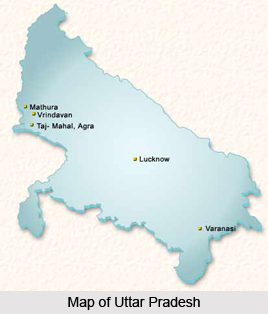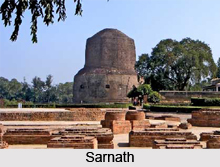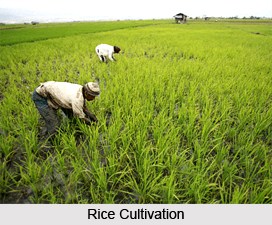 Uttar Pradesh is India`s fourth largest and the most populated state in India. Uttar Pradesh is bordered by Nepal and the Indian states of Bihar, Jharkhand, Himachal Pradesh, Madhya Pradesh, Rajasthan, Haryana, Uttaranchal and Delhi. Uttar Pradesh is steeped in history and is rich with natural resources. The state is situated in north India and has a population of 199 million people. Uttar Pradesh is second ranked India state in terms of economy. Uttar Pradesh is spread over a vast portion of northern India, with an area of 243,290 sq km, and covers most of the upper Gangetic plain. Lucknow is the administrative capital, where as Kanpur is the industrial hub of the state. Uttar Pradesh includes numerous cities of historical importance like Varanasi, Agra, Kanpur, Allahabad, Aligarh and Lucknow. There are several districts of Uttar Pradesh as well. It is also well known as a popular tourist destination amongst national and international visitors.
Uttar Pradesh is India`s fourth largest and the most populated state in India. Uttar Pradesh is bordered by Nepal and the Indian states of Bihar, Jharkhand, Himachal Pradesh, Madhya Pradesh, Rajasthan, Haryana, Uttaranchal and Delhi. Uttar Pradesh is steeped in history and is rich with natural resources. The state is situated in north India and has a population of 199 million people. Uttar Pradesh is second ranked India state in terms of economy. Uttar Pradesh is spread over a vast portion of northern India, with an area of 243,290 sq km, and covers most of the upper Gangetic plain. Lucknow is the administrative capital, where as Kanpur is the industrial hub of the state. Uttar Pradesh includes numerous cities of historical importance like Varanasi, Agra, Kanpur, Allahabad, Aligarh and Lucknow. There are several districts of Uttar Pradesh as well. It is also well known as a popular tourist destination amongst national and international visitors.
The two sacred rivers that flow through Uttar Pradesh are the Ganga River and Yamuna River. The most important tourist sites of Uttar Pradesh are the Taj Mahal, Agra Fort, Fatehpur Sikri and Dayal Bagh. Some of the esteemed writers in Hindu sacred literature, such as Yajnavalkya, Vashishta, Vishwamitra, Valmiki, Attriyea, Bharadwaja and Kapil lived in Uttar Pradesh. Moreover, eight of India`s prime ministers hail from Uttar Pradesh, namely, Jawaharlal Nehru, Lal Bahadur Shastri, Indira Gandhi, Rajiv Gandhi, Charan Singh, Vishwanath Pratap Singh, Chandra Shekhar Singh and Atal Bihari Vajpayee.
History of Uttar Pradesh
The History of Uttar Pradesh is very much associated with the broad history of India. The state`s history dates back to 4000 years. Formerly the area of Uttar Pradesh was occupied by Aryans and their main occupation was agriculture. The Aryans through conquests occupied the adjoining areas. They laid the foundations of Hindu civilisation in the region. The Chaukhandi Stupa here marks the spot where Lord Buddha met his disciples. The Dhamek Stupa in Sarnath commemorates Buddha`s first sermon. Besides Kuru, Panchalas, Vatsas, and Videhas etc. formed the early region of the state. These regions were known as Madhyadesa. During Ashoka`s rule, several public welfare works was taken up. The British East India Company came into contact with the Awadh rulers during the reign of 3rd Nawab of Awadh. During the British rule, the contribution of the people of the state in the Indian freedom struggle had been significant.
 Geography of Uttar Pradesh
Geography of Uttar Pradesh
Uttar Pradesh is bound by Bihar in the east, Madhya Pradesh in the south, Rajasthan, Delhi, Himachal Pradesh and Haryana in the west and Uttaranchal in the north and Nepal touches the northern border of Uttar Pradesh. The Ganga and Yamuna flows through the state. As this state shares an international boundary it assumes strategic importance as far as its defence is concerned. Total area of Uttar Pradesh is 243,290 sq km. This state lies between latitude 24 degree to 31 degree and longitude 77 degree to 84 degree east. The major part of Indo-Gangetic plain or the north fertile plain forms Uttar Pradesh. The state is endowed with natural wealth which is found below a variety of rocks in lofty mountain ranges of the Himalaya Mountains in the north and Vindhya Mountain Range in the south.
Uttar Pradesh is also rich in diversity of flora and fauna due to its vast area, big and small rivers, varieties of climatic conditions, and different kinds of soils. The major minerals found in Uttar Pradesh include limestone, dolomite, glass-sand, marble, bauxite, non-plastic fireclay, and Uranium. Sand-stone, pebbles, salt punter, sand and other minor minerals are also found in the state. The plains of Uttar Pradesh have been very rich in natural vegetation which has, however, diminished due to wide-ranging needs of the people. About 12.8 percent of the geographical areas of Uttar Pradesh are under forests.
Demography of Uttar Pradesh
India`s most populous state is Uttar Pradesh. It has a population density of about 166,052,859 as per the 2001 census. There is an average density of 689 persons per sq km that is around 1,785 per sq metres. Out of the total population Hindu population constitute around 82 percent and Muslim population constitute 17 percent. The main language spoken by the people here is Hindi language but Urdu language is also widely spoken here.
Culture of Uttar Pradesh
The majority of the population of Uttar Pradesh are Hindus. The state is entangled under rigid caste system. In the state, there is the presence of a mixture of cities and villages as a result some part of the state is traditional and other part is modern. Uttar Pradesh is renowned for its art and architecture.
 Varanasi is famous for saris and silks, Mirzapur and Bhadohi are famous for carpet making, Agra and Kanpur for their leather craft, Moradabad for its metal ware, Lucknow for its cloth work and embroidery, and the entire state for its pottery all around the world. The important festivals celebrated by the Hindus of Uttar Pradesh are Karva Chauth, Dussehra, Ahoi Astami, Bhaiya Dooj, Shitla Ashtami, Ramnavami, Baisakhi Purnima, Guru Purnima, etc.
Varanasi is famous for saris and silks, Mirzapur and Bhadohi are famous for carpet making, Agra and Kanpur for their leather craft, Moradabad for its metal ware, Lucknow for its cloth work and embroidery, and the entire state for its pottery all around the world. The important festivals celebrated by the Hindus of Uttar Pradesh are Karva Chauth, Dussehra, Ahoi Astami, Bhaiya Dooj, Shitla Ashtami, Ramnavami, Baisakhi Purnima, Guru Purnima, etc.
Education in Uttar Pradesh
Uttar Pradesh has several general universities and other institutions. Some of the famous universities are Lucknow University, Allahabad University, Banaras Hindu University, Aligarh Muslim University, Kanpur University, Agra University, Chaudhary Charan Singh University, Uttar Pradesh Technical University, Indian Institute of Technology Kanpur, Indian Institute of Management Lucknow, Indian Institute of Information Technology , National Institute of Technology etc. Female literacy situation in Uttar Pradesh is dismal.
Administration of Uttar Pradesh
Uttar Pradesh has a bicameral legislature and a Governor. The lower house is called Vidhan Sabha and the Upper House is called as Vidhan Parishad. The state has also a high court. The state government`s Department of Planning is responsible for making developmental plan for the state. The state has the presence of a large number of village councils that are known as Panchayats.
Economy of Uttar Pradesh
In Uttar Pradesh, there is the presence of different types of minerals. Several industries have come up in the region based on the presence of different types of minerals present in the region. The industries are engaged in the manufacturing of scales, letter boxes, furniture, locks, leather goods, scissor, badges and belts, handloom, carpet, glass, electrical goods etc. In the western regions of Uttar Pradesh, majority of the people depends on agriculture and other allied activities. Wheat, pulses, oilseeds, rice, sugarcane, and potatoes are the main crops grown here. Sugarcane is an important cash crop grown here. Apples and mangoes are also produced in this state.

Tourism in Uttar Pradesh
Known for ages for its rich ancient traditions, Uttar Pradesh abounds in places of religious importance. There are also a large number of places which cannot be only called places of pilgrimage but which have great importance from historical and tourist point of view also. The state is specially known for its cultural centres.
Blessed with a variety of geographical land and much cultural diversity, Uttar Pradesh is the rainbow land where the diversified Indian culture has blossomed from time immemorial. Rich and tranquil expanses of meadows, perennial rivers, and dense forest sand and fertile soil, Uttar Pradesh has contributed numerous golden chapters to the archives of Indian history. Dotted with various holy shrines and religious places, full of joyous festivals, it plays an important role in the politics, education, culture, industry, agriculture and tourism of India.






